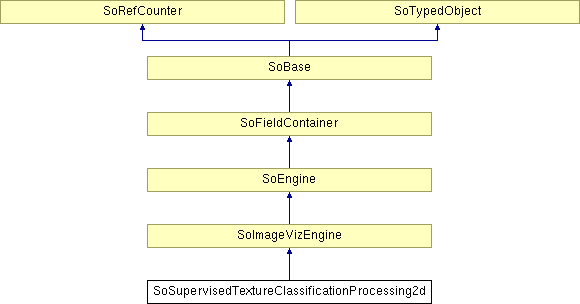SoSupervisedTextureClassificationProcessing2d Class Reference
[Classification]
 SoSupervisedTextureClassificationProcessing2d engine
More...
SoSupervisedTextureClassificationProcessing2d engine
More...
#include <ImageViz/Engines/ImageSegmentation/Classification/SoSupervisedTextureClassificationProcessing2d.h>

Public Types | |
| enum | FeatureGroup { DIRECTIONAL_COOCCURRENCE = 1, ROTATION_INVARIANT_COOCCURRENCE = 2, FIRST_ORDER_STATISTICS = 4, HISTOGRAM_STATISTICS = 8, INTENSITY = 16 } |
| enum | CoocTextonShape { CUBE = 0, SPHERE = 1, BALL = 2 } |
| enum | OutMapType { CLOSEST_DISTANCE = 0, RELATIVE_DISTANCE = 1, CLASS_DISTANCE = 2, NONE = 3 } |
Public Member Functions | |
| SoSupervisedTextureClassificationProcessing2d () | |
Public Attributes | |
| SoSFImageDataAdapter | inImage |
| SoSFImageDataAdapter | inTrainingImage |
| SoSFBitMask | featureGroup |
| SoSFVec2i32 | radiusRange |
| SoSFUInt32 | radiusStep |
| SoSFUInt32 | coocRadius |
| SoSFEnum | coocTextonShape |
| SoSFUInt32 | coocTextonSize |
| SoSFDouble | minSeparationPercentage |
| SoImageVizEngineOutput < SoSFImageDataAdapter, SoImageDataAdapter * > | outLabelImage |
| SoSFEnum | outMapType |
| SoImageVizEngineOutput < SoSFImageDataAdapter, SoImageDataAdapter * > | outMapImage |
Detailed Description
 SoSupervisedTextureClassificationProcessing2d engine
SoSupervisedTextureClassificationProcessing2d engine
The SoSupervisedTextureClassificationProcessing3d engine realizes a segmentation based on a texture model automatically built from a training input image.
It chains automatically the 3 steps of the texture classification workflow: model creation, texture model learning and model application.
For an introduction see the Texture classification section
FILE FORMAT/DEFAULT
- SupervisedTextureClassificationProcessing2d {
| inImage | NULL |
| inTrainingImage | NULL |
| featureGroup | DIRECTIONAL_COOCCURRENCE | ROTATION_INVARIANT_COOCCURRENCE | FIRST_ORDER_STATISTICS | HISTOGRAM_STATISTICS | INTENSITY |
| radiusRange | 2 14 |
| radiusStep | 4 |
| coocRadius | 10 |
| coocTextonShape | SPHERE |
| coocTextonSize | 4 |
| minSeparationPercentage | 3.0 |
| outMapType | CLOSEST_DISTANCE |
Library references: SupervisedTextureClassification2d
Member Enumeration Documentation
This enum defines all type of measures used for texture classification.
- Enumerator:
This enum defines all type of measures used for texture classification.
- Enumerator:
- Enumerator:
Constructor & Destructor Documentation
| SoSupervisedTextureClassificationProcessing2d::SoSupervisedTextureClassificationProcessing2d | ( | ) |
Constructor.
Member Data Documentation
Radius of the circular neighborhood used by the cooccurrence features.
Default value is 10.
The shape of the co-occurrence texton, i.e., the pattern defined by the set of co-occurrence vectors.
This shape represents the distribution of points around the target point for computing the co-occurrence matrix. The shape, associated to the texton size, defines the set of vectors that are used for computing co-occurrence features. For instance, in 2D, a Cube shape of size 3 defines the co-occurrence vectors (-3, -3) , (0, -3), (3, -3), (-3, 0) , (3, 0), (-3, 3) , (0, 3) and (3, 3). This parameter is ignored if none of the co-occurrence measure types is selected. Use enum CoocTextonShape. Default is SPHERE
The size of the texton shape for co-occurrence features.
This size is constrained by the radius parameter. The constraint depends on the texton shape. For instance, with a square texton, the texton size cannot exceed the rounded value of
![\[ radius \times \sqrt{2} \]](form_543.png)
. This parameter is ignored if none of the co-occurrence measure types is selected. Default value is 4.
The groups of textural features to compute.
Use enum FeatureGroup. Default is DIRECTIONAL_COOCCURRENCE | ROTATION_INVARIANT_COOCCURRENCE | FIRST_ORDER_STATISTICS | HISTOGRAM_STATISTICS | INTENSITY
The input grayscale image to segment.
Default value is NULL. Supported types include: grayscale image.
The input label training image (16 or 32 bits).
Each label represents a class sample for the learning step. Default value is NULL. Supported types include: label image.
This parameter controls the rejection criteria of the feature selection algorithm (FS).
A measure is rejected if its contribution does not increase enough the separation power of the classification model. This ratio indicates the minimal relative growth required to keep a measure. Please refer to Feature Selection section for more information about this parameter. The value must be greater than or equal to 0.0. Default value is 3.0.
| SoImageVizEngineOutput<SoSFImageDataAdapter,SoImageDataAdapter*> SoSupervisedTextureClassificationProcessing2d::outLabelImage |
The output label image representing the texture classification result.
Default value is NULL. Supported types include: label image.
| SoImageVizEngineOutput<SoSFImageDataAdapter,SoImageDataAdapter*> SoSupervisedTextureClassificationProcessing2d::outMapImage |
Output map image.
The type of the image will be float. Default value is NULL. Supported types include: grayscale binary label color image.
The Output map image type.
Default is CLOSEST_DISTANCE. Use enum OutMapType. Default is CLOSEST_DISTANCE
The minimum and maximum radius of the circular neighborhoods used for computing textural features.
Default value is SbVec2i32(2,14).
The step used to define the set of radius between minimum and maximum.
The maximum radius is systematically added to the radius list. Default value is 4.
The documentation for this class was generated from the following file:
- ImageViz/Engines/ImageSegmentation/Classification/SoSupervisedTextureClassificationProcessing2d.h